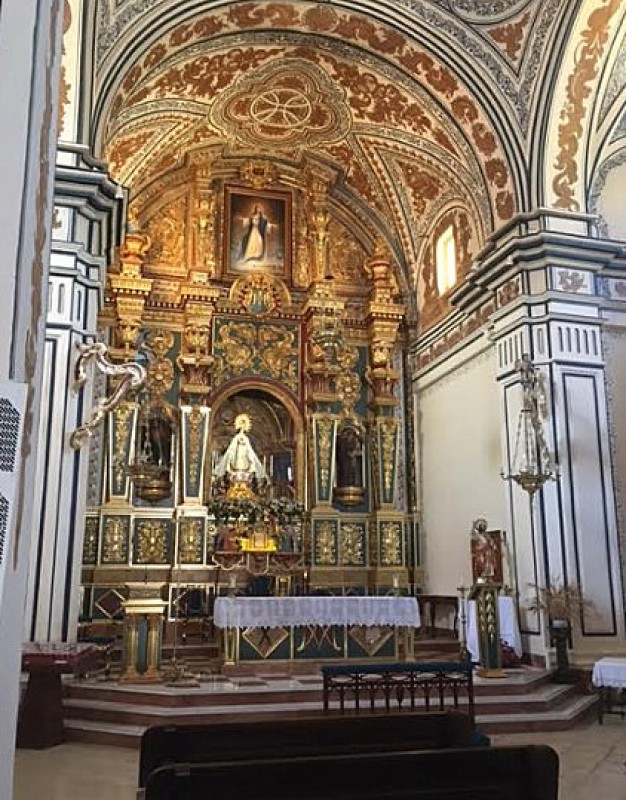Iglesia del Convento de la Purísima, Mazarrón
The church of La Purísima in Mazarrón

16th-18th century Iglesia del Convento de la Purísima
The Convento de la Purísima is located in the heart of the old town of Mazarrón, overlooking the main market square which formerly housed the Plaza de Abastos or indoor marketplace.
 It's not clear when the cult of the Virgen de la Concepción began in Mazarrón, the first recorded evidence being a book by Fray Ginés García in 1756, which records the founding of a brotherhood of the same name in 1549. The book says that the existing chapel was enlarged a year later, which indicates that there was some sort of religious structure on the site before this date, although what form it took is not known.
It's not clear when the cult of the Virgen de la Concepción began in Mazarrón, the first recorded evidence being a book by Fray Ginés García in 1756, which records the founding of a brotherhood of the same name in 1549. The book says that the existing chapel was enlarged a year later, which indicates that there was some sort of religious structure on the site before this date, although what form it took is not known.
The more substantial church was completed by 1565 and it is known that a new sculpture of the Virgin was acquired between 1565 and 1573 to replace a previous one. A new hospital was also constructed by Franciscan monks, and this later became a monastery. These events coincided with Mazarrón achieving its independence from Lorca in 1572.
The church is closely connected to a highly significant event known as the Miracle of La Purísima, which took place in Mazarrón in 1585. This event is commemorated annually on the 17th November, the day on which the Virgen de la Purísima is said to have saved the town of Mazarrón from a Berber pirate attack.

At that point in its history Mazarrón was a mining, farming and fishing town, also boasting salt flats. Across the Mediterranean, though, were enemies, and the coastline was subject to frequent attack as raiders carried off villagers (to ransom or sell as slaves), livestock and anything else of value, including crops.
 The local watchtowers of the Torre de los Caballos and the Torre de la Cala del Moro Santo were just part of a chain of lookout points along the coast of Murcia to warn of attack. However, in May 1573 the fishing boats of Mazarrón were stolen and in December of the same year 25 boats are recorded as having menaced the coast. All the townspeople hiding in caves were found and taken away.
The local watchtowers of the Torre de los Caballos and the Torre de la Cala del Moro Santo were just part of a chain of lookout points along the coast of Murcia to warn of attack. However, in May 1573 the fishing boats of Mazarrón were stolen and in December of the same year 25 boats are recorded as having menaced the coast. All the townspeople hiding in caves were found and taken away.
In 1585, the event known as the Miracle of Mazarrón took place. On 17th November Berber pirates sailed to the coast to attack Mazarrón in an expedition headed by the famous pirate Morato Arráez, legendary across the Region for his incursions and attacks. On board his ship was a man called Mami, who had once worked in Mazarrón but was now working as a servant to the pirate.
Legend says that the first miracle of the Virgin of the Purisima was the intervention of Mami, who persuaded the captain to hold back from a full attack and instead send out a scouting party: this is said to be on account of the friendly treatment he had received when working in Mazarrón.
The second stage occurred when the scouting party approached the village, creeping up as men sat outside playing cards. Miraculously, as they played the evening bells rang out, announcing the sunset and fall of night, but for a reason no-one has ever managed to explain, that night the wrong bell rope was pulled and the alarm signal rang, alerting the town to the approach of pirates.
The cardplayers leapt to their feet, one man shouting out in frustration that he had 14 horses, a term that apparently was significant to the card players, but which lead the muslim invaders to assume that a mounted force had anticipated their attack and that 14 horsemen awaited them, intent on slaughter: in consequence they fled back to the beach.
 At this point a woman appeared on the beach, radiating light, arms raised to the heavens, a spectacle which terrorized the scouts to such an extent that they fled, throwing their weapons into the sea, and sailed away from Mazarrón, saving the village from certain pillage and probable destruction.
At this point a woman appeared on the beach, radiating light, arms raised to the heavens, a spectacle which terrorized the scouts to such an extent that they fled, throwing their weapons into the sea, and sailed away from Mazarrón, saving the village from certain pillage and probable destruction.
The villagers went to the church of La Concepción to give thanks for their delivery and realized to their amazement that the lamp shining out next to the statue of the Virgin shone without oil, that the head of the Virgin was turned towards the sea, and her robe was wet with seawater and peppered with sand.
Many testified to having seen this miraculous event, and this was borne out years later when white flowers mysteriously bloomed on the beach, announcing to all that there had indeed been a miracle in Bolnuevo.
Each year the figure of the Virgin is carried from chapel in Bolnuevo to Mazarrón, returning in triumph a week later. This "romería" is extremely popular among both Spanish and expat residents, thousands gathering on the beach following the Romería to enjoy a barbecue and a relaxing afternoon.
(Click for a report following the 2010 Romeria, Bolnuevo, Fiestas del Milagro.)
 Over the years there have been 5 different images of the Virgin in this Mazarrón church. The first was replaced during the chapel expansion in around 1565, and the second is the one which performed the miracle. Inside the church today is a glass case containing what is said to have been the flag of the Virgin when the miracle occurred, now just a few fragments of worn silk.
Over the years there have been 5 different images of the Virgin in this Mazarrón church. The first was replaced during the chapel expansion in around 1565, and the second is the one which performed the miracle. Inside the church today is a glass case containing what is said to have been the flag of the Virgin when the miracle occurred, now just a few fragments of worn silk.
This image remained in the chapel through subsequent expansions in the 18th century as the original was chapel absorbed into the new structure. All that remains today of the original building is the exquisitely painted Camarín of the Virgen where the current figure is housed.
The second image was burnt during the Spanish Civil War in 1937 and was temporarily replaced by another in 1939, and then in 1940 the fourth, sculpted by Anastasia Martínez, was purchased by donations. This one remained in the church until 1949 when it was transferred to the chapel in Bolnuevo to be replaced by the current sculpture.
The church also plays an important ròle in the Semana Santa processions in Easter Week, housing the scuptures which are paraded through the streets. To celebrate this link there is a sculpture of a Nazarene, wearing the pointed "capirote" of the penitent in the gardens next to the church.
The church is beautifully painted and stands in a tranquil and peaceful setting, and it is well worth popping in. The doors are always unlocked on Saturday mornings, when the weekly market takes place in the Plaza outside.
Mass times
 These vary from season to season, but Mass is usually only held in the church on a Saturday evening as the main church of Mazarrón is now San Andrés.
These vary from season to season, but Mass is usually only held in the church on a Saturday evening as the main church of Mazarrón is now San Andrés.
Winter (October to Easter): Saturday 19.00
Summer (incuding September): Saturday 21.00
The best advice is to double check if making a special journey, either by looking at the notice outside or calling the parish number (968 592302) or the Mazarrón tourist office.
Click for map, Plaza del Convento Mazarrón.
For more local information visit the home page of Mazarrón Today.
Sights to see in Mazarrón








































